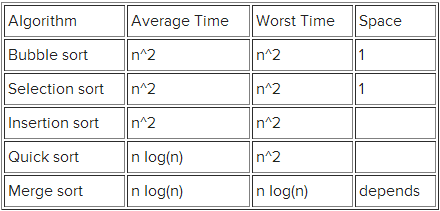面试常见十大类算法汇总
标签: 面试 算法 | 发表时间:2016-01-06 01:19 | 作者:
出处:http://www.iteye.com
1.String/Array/Matrix
在Java中,String是一个包含char数组和其它字段、方法的类。如果没有IDE自动完成代码,下面这个方法大家应该记住:
toCharArray() //get char array of a String Arrays.sort() //sort an array Arrays.toString(char[] a) //convert to string charAt(int x) //get a char at the specific index length() //string length length //array size substring(int beginIndex) substring(int beginIndex, int endIndex) Integer.valueOf()//string to integer String.valueOf()/integer to string
String/arrays很容易理解,但与它们有关的问题常常需要高级的算法去解决,例如动态编程、递归等。
下面列出一些需要高级算法才能解决的经典问题:
- Evaluate Reverse Polish Notation
- Longest Palindromic Substring
- 单词分割
- 字梯
- Median of Two Sorted Arrays
- 正则表达式匹配
- 合并间隔
- 插入间隔
- Two Sum
- 3Sum
- 4Sum
- 3Sum Closest
- String to Integer
- 合并排序数组
- Valid Parentheses
- 实现strStr()
- Set Matrix Zeroes
- 搜索插入位置
- Longest Consecutive Sequence
- Valid Palindrome
- 螺旋矩阵
- 搜索一个二维矩阵
- 旋转图像
- 三角形
- Distinct Subsequences Total
- Maximum Subarray
- 删除重复的排序数组
- 删除重复的排序数组2
- 查找没有重复的最长子串
- 包含两个独特字符的最长子串
- Palindrome Partitioning
2.链表
在Java中实现链表是非常简单的,每个节点都有一个值,然后把它链接到下一个节点。
class Node { int val; Node next; Node(int x) { val = x; next = null; } } 比较流行的两个链表例子就是栈和队列。
栈(Stack)
class Stack{ Node top; public Node peek(){ if(top != null){ return top; } return null; } public Node pop(){ if(top == null){ return null; }else{ Node temp = new Node(top.val); top = top.next; return temp; } } public void push(Node n){ if(n != null){ n.next = top; top = n; } } } 队列(Queue)
class Queue{ Node first, last; public void enqueue(Node n){ if(first == null){ first = n; last = first; }else{ last.next = n; last = n; } } public Node dequeue(){ if(first == null){ return null; }else{ Node temp = new Node(first.val); first = first.next; return temp; } } } 值得一提的是,Java标准库中已经包含一个叫做Stack的类,链表也可以作为一个队列使用(add()和remove())。(链表实现队列接口)如果你在面试过程中,需要用到栈或队列解决问题时,你可以直接使用它们。
在实际中,需要用到链表的算法有:
- 插入两个数字
- 重新排序列表
- 链表周期
- Copy List with Random Pointer
- 合并两个有序列表
- 合并多个排序列表
- 从排序列表中删除重复的
- 分区列表
- LRU缓存
3.树&堆
这里的树通常是指二叉树。
class TreeNode{ int value; TreeNode left; TreeNode right; } 下面是一些与二叉树有关的概念:
- 二叉树搜索:对于所有节点,顺序是:left children <= current node <= right children;
- 平衡vs.非平衡:它是一 棵空树或它的左右两个子树的高度差的绝对值不超过1,并且左右两个子树都是一棵平衡二叉树;
- 满二叉树:除最后一层无任何子节点外,每一层上的所有结点都有两个子结点;
- 完美二叉树(Perfect Binary Tree):一个满二叉树,所有叶子都在同一个深度或同一级,并且每个父节点都有两个子节点;
- 完全二叉树:若设二叉树的深度为h,除第 h 层外,其它各层 (1~h-1) 的结点数都达到最大个数,第 h 层所有的结点都连续集中在最左边,这就是完全二叉树。
堆(Heap)是一个基于树的数据结构,也可以称为优先队列( PriorityQueue ),在队列中,调度程序反复提取队列中第一个作业并运行,因而实际情况中某些时间较短的任务将等待很长时间才能结束,或者某些不短小,但具有重要性的作业,同样应当具有优先权。堆即为解决此类问题设计的一种数据结构。
下面列出一些基于二叉树和堆的算法:
- 二叉树前序遍历
- 二叉树中序遍历
- 二叉树后序遍历
- 字梯
- 验证二叉查找树
- 把二叉树变平放到链表里
- 二叉树路径和
- 从前序和后序构建二叉树
- 把有序数组转换为二叉查找树
- 把有序列表转为二叉查找树
- 最小深度二叉树
- 二叉树最大路径和
- 平衡二叉树
4.Graph
与Graph相关的问题主要集中在深度优先搜索和宽度优先搜索。深度优先搜索非常简单,你可以从根节点开始循环整个邻居节点。下面是一个非常简单的宽度优先搜索例子,核心是用队列去存储节点。

第一步,定义一个GraphNode
class GraphNode{ int val; GraphNode next; GraphNode[] neighbors; boolean visited; GraphNode(int x) { val = x; } GraphNode(int x, GraphNode[] n){ val = x; neighbors = n; } public String toString(){ return "value: "+ this.val; } } 第二步,定义一个队列
class Queue{ GraphNode first, last; public void enqueue(GraphNode n){ if(first == null){ first = n; last = first; }else{ last.next = n; last = n; } } public GraphNode dequeue(){ if(first == null){ return null; }else{ GraphNode temp = new GraphNode(first.val, first.neighbors); first = first.next; return temp; } } } 第三步,使用队列进行宽度优先搜索
public class GraphTest { public static void main(String[] args) { GraphNode n1 = new GraphNode(1); GraphNode n2 = new GraphNode(2); GraphNode n3 = new GraphNode(3); GraphNode n4 = new GraphNode(4); GraphNode n5 = new GraphNode(5); n1.neighbors = new GraphNode[]{n2,n3,n5}; n2.neighbors = new GraphNode[]{n1,n4}; n3.neighbors = new GraphNode[]{n1,n4,n5}; n4.neighbors = new GraphNode[]{n2,n3,n5}; n5.neighbors = new GraphNode[]{n1,n3,n4}; breathFirstSearch(n1, 5); } public static void breathFirstSearch(GraphNode root, int x){ if(root.val == x) System.out.println("find in root"); Queue queue = new Queue(); root.visited = true; queue.enqueue(root); while(queue.first != null){ GraphNode c = (GraphNode) queue.dequeue(); for(GraphNode n: c.neighbors){ if(!n.visited){ System.out.print(n + " "); n.visited = true; if(n.val == x) System.out.println("Find "+n); queue.enqueue(n); } } } } } 输出结果:
value: 2 value: 3 value: 5 Find value: 5value: 4
实际中,基于Graph需要经常用到的算法:
- 克隆Graph
5.排序
不同排序算法的时间复杂度,大家可以到wiki上查看它们的基本思想。

BinSort、Radix Sort和CountSort使用了不同的假设,所有,它们不是一般的排序方法。
下面是这些算法的具体实例,另外,你还可以阅读: Java开发者在实际操作中是如何排序的 。
- 归并排序
- 快速排序
- 插入排序
6.递归和迭代
下面通过一个例子来说明什么是递归。
问题:
这里有n个台阶,每次能爬1或2节,请问有多少种爬法?
步骤1:查找n和n-1之间的关系
为了获得n,这里有两种方法:一个是从第一节台阶到n-1或者从2到n-2。如果f(n)种爬法刚好是爬到n节,那么f(n)=f(n-1)+f(n-2)。
步骤2:确保开始条件是正确的
f(0) = 0;f(1) = 1;
public static int f(int n){ if(n <= 2) return n; int x = f(n-1) + f(n-2); return x; } 递归方法的时间复杂度指数为n,这里会有很多冗余计算。
f(5) f(4) + f(3) f(3) + f(2) + f(2) + f(1) f(2) + f(1) + f(2) + f(2) + f(1)
该递归可以很简单地转换为迭代。
public static int f(int n) { if (n <= 2){ return n; } int first = 1, second = 2; int third = 0; for (int i = 3; i <= n; i++) { third = first + second; first = second; second = third; } return third; } 在这个例子中,迭代花费的时间要少些。关于迭代和递归,你可以去 这里 看看。
7.动态规划
动态规划主要用来解决如下技术问题:
- 通过较小的子例来解决一个实例;
- 对于一个较小的实例,可能需要许多个解决方案;
- 把较小实例的解决方案存储在一个表中,一旦遇上,就很容易解决;
- 附加空间用来节省时间。
上面所列的爬台阶问题完全符合这四个属性,因此,可以使用动态规划来解决:
public static int[] A = new int[100]; public static int f3(int n) { if (n <= 2) A[n]= n; if(A[n] > 0) return A[n]; else A[n] = f3(n-1) + f3(n-2);//store results so only calculate once! return A[n]; } 一些基于动态规划的算法:
- 编辑距离
- 最长回文子串
- 单词分割
- 最大的子数组
8.位操作
位操作符:

从一个给定的数n中找位i(i从0开始,然后向右开始)
public static boolean getBit(int num, int i){ int result = num & (1<<i); if(result == 0){ return false; }else{ return true; } } 例如,获取10的第二位:
i=1, n=10 1<<1= 10 1010&10=10 10 is not 0, so return true;
典型的位算法:
- Find Single Number
- Maximum Binary Gap
9.概率
通常要解决概率相关问题,都需要很好地格式化问题,下面提供一个简单的例子:
有50个人在一个房间,那么有两个人是同一天生日的可能性有多大?(忽略闰年,即一年有365天)
算法:
public static double caculateProbability(int n){ double x = 1; for(int i=0; i<n; i++){ x *= (365.0-i)/365.0; } double pro = Math.round((1-x) * 100); return pro/100; } 结果:
calculateProbability(50) = 0.97
10.组合和排列
组合和排列的主要差别在于顺序是否重要。
例1:
1、2、3、4、5这5个数字,输出不同的顺序,其中4不可以排在第三位,3和5不能相邻,请问有多少种组合?
例2:
有5个香蕉、4个梨、3个苹果,假设每种水果都是一样的,请问有多少种不同的组合?
基于它们的一些常见算法
- 排列
- 排列2
- 排列顺序
来自: ProgramCreek CSDN
ITeye推荐
- —软件人才免语言低担保 赴美带薪读研!—











![[HBLOG]公众号](https://www.liuhaihua.cn/img/qrcode_gzh.jpg)

